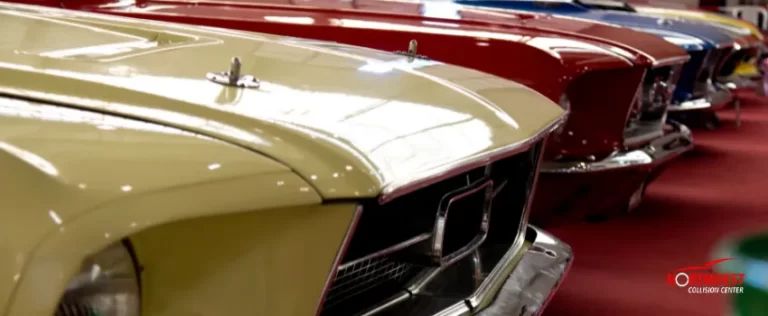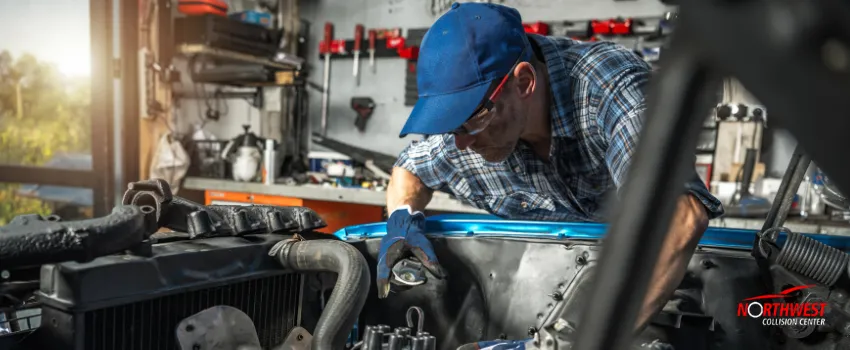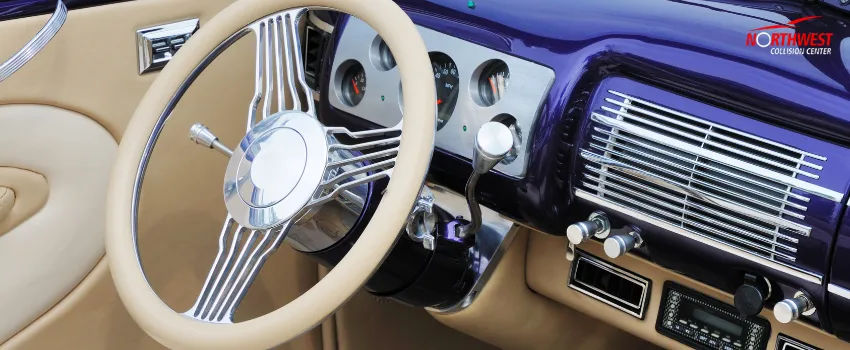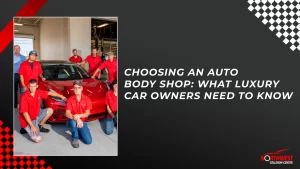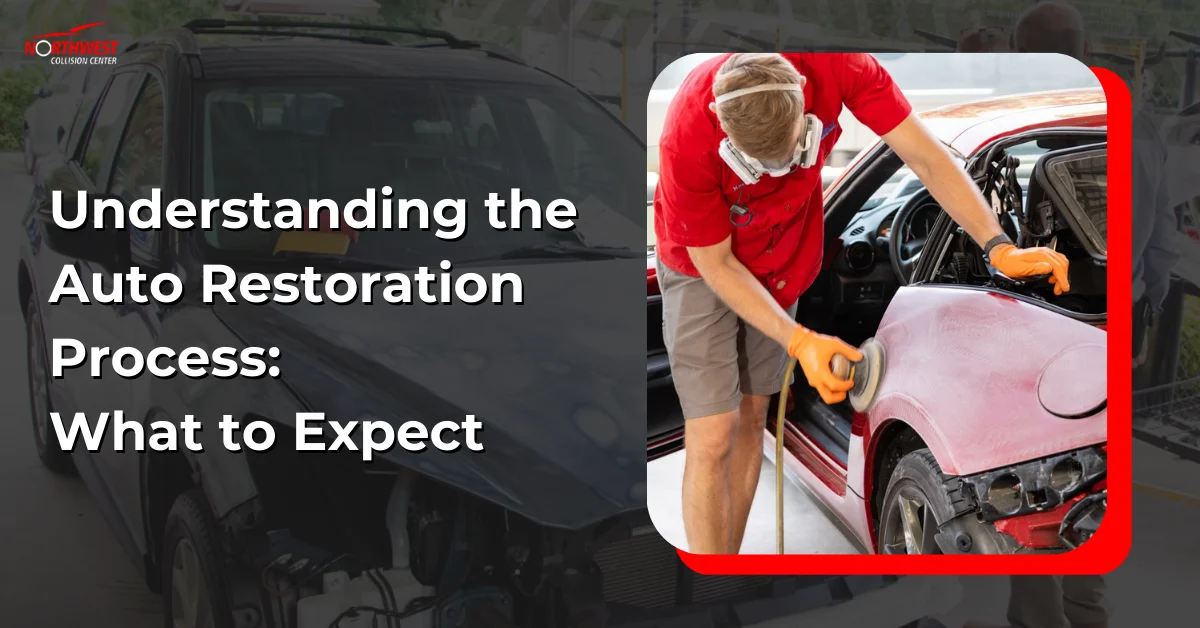Keeping classic cars in good shape today is a constant challenge, blending human skill, old-world machinery, and the relentless passage of time. Thankfully, each year introduces new methods to keep these vintage cars functional and visually stunning, just like when they first left the factory. However, the task of modern vintage auto body repair is substantial. The older the car, the more attention and care it demands.
Despite technological advances, a significant amount of intricate, hands-on work is still involved in classic car restoration. The expertise and modern techniques professional restorers use are incredibly effective, often achieving remarkable results. Follow along as we explore how to restore classic cars and skillfully return them to their former glory.
What is a Classic Car Restoration?
Classic car restoration is fixing old cars to make them look and work like new ones again. It’s all about returning the vehicle to how it was when it first came out, so everything needs to be as it was in the past. When you restore classic cars, you’re making sure they are exactly how they were initially, down to the minor details.
The work needed to restore a classic car depends on how the car looks and works when you start. Some old vehicles might need just a few fixes, but others might need much more work.
If you’re working on a modern vintage car restoration that requires much fixing, getting professional help is a good idea. They know all about how to bring these old cars back to life the right way.
Modern Repair Techniques for Classic Car Restoration
Modern repair techniques have revolutionized the classic car restoration industry, making the process more efficient and precise. These techniques leverage advanced technology and innovative methods to achieve exceptional results. Here are some of the modern repair techniques commonly used in classic car restoration:
1. Computer-Aided Design (CAD)
Computer-aided design (CAD) plays a vital role in classic car restoration. It allows restorers to create detailed digital models of the car, enabling them to plan and visualize the restoration process accurately. CAD software also aids in the manufacturing of custom parts by providing precise measurements and specifications.
2. 3D Printing
When fabricating rare or hard-to-find parts, 3D printing has become a game-changer. This modern technique can produce complex, customized components with accuracy and speed. 3D printing is handy for creating plastic and metal parts, and it significantly reduces the time and costs involved with traditional manufacturing methods.
3. Laser Scanning
Laser scanning accurately captures the car’s existing dimensions and shape. This technology creates a digital 3D model of the vehicle, which serves as a reference for precise measurements during the restoration. Laser scanning is especially beneficial for achieving accuracy when working on intricate bodywork or modifying parts.
4. Paintless Dent Repair (PDR)
Paintless dent repair (PDR) is a modern technique that has simplified the restoration of minor dents and dings in classic cars. This method massages the damaged area from the inside, eliminating the need for traditional, time-consuming bodywork. PDR saves time and preserves the original paint finish while maintaining the car’s authenticity.
5. Plasma Cutting
Plasma cutting is a modern method for precise and efficient metalwork in classic car restoration. This technique allows restorers to cut through various metals easily, enabling them to create custom parts and accurately make intricate repairs.
6. Soda Blasting
Soda blasting is a modern alternative to traditional sandblasting. It uses bicarbonate soda particles blasted at high pressure to remove paint and rust from the car’s body. Unlike sandblasting, soda blasting is gentler and does not harm the underlying metal, making it ideal for delicate or intricate parts.
7. Chemical Stripping
Chemical stripping involves using specially formulated solutions to remove paint and other coatings from the car’s body. This technique is highly effective in reaching areas that are difficult to access. Chemical stripping minimizes the risk of damage to the car’s original metalwork, as it does not require physical abrasion.
8. Ceramic Coating
A modern ceramic coating is a protective layer applied to the car’s exterior. It provides several benefits, including enhanced paint durability and resistance to UV rays and chemical damage. Ceramic coating is a popular choice for classic car owners as it helps preserve the freshly restored appearance for an extended period.
The Process of Restoring a Classic Car
Restoring a classic car is more than just a hobby. It’s an act of passion that blends time, patience, and a deep knowledge of the vehicle’s heritage and architecture. Each classic car restoration project is a unique adventure, but they typically follow a similar path. Let’s delve into the steps involved in reviving a classic car:
1. Planning and Research
A successful modern vintage car restoration begins with a well-thought-out plan. Identify the make, model, and year of the car and establish clear restoration goals. Decide on the restoration level you’re aiming for:
- Concours – This level is about achieving perfection, replicating the car’s original state in every detail.
- Street Show – Combining originality with modern upgrades, this level is for cars that will be showcased at car events and shows and driven occasionally.
- Driver – Ideal for those who want to drive their classic car regularly. This focuses on roadworthiness while maintaining its vintage charm.
Thorough research is crucial. Learn about your car’s original features and historical background to guide your restoration process.
2. Evaluation and Disassembly
Before restoring classic cars, expert technicians start by assessing the cars’ condition, noting what needs repair or replacement. This evaluation helps in budgeting and planning the timeline.
They then disassemble the car, documenting everything with photos to help in reassembly later. This step is crucial for understanding the car’s original state and requirements.
3. Sourcing Parts and Modern Alternatives
When restoring classic cars, finding the right parts is an essential step. Technicians generally look at:
-
- Original parts suppliers
-
- Salvage yards
-
- Online marketplaces and forums
Sometimes, when restoring classic cars, modern alternatives might be used when original parts are unavailable or too costly. These can offer better performance and durability while keeping the classic look.
4. Repair, Restoration, and Modern Upgrades
With the mechanicals in good shape, it’s time to shift to the car’s body. Depending on the condition of the original bodywork, you may choose one of three paths: repair, reconditioning, or replacement. Let’s take a closer look at each of these options:
- Repair – Repair may be the best course of action in modern vintage car repair if the body has only minor dents, scratches, or rust. Skilled craftsmen can work their magic, using traditional techniques like hammering and welding to restore the body to its former glory. Opting for repairs can help preserve the car’s original character and save you money.
- Reconditioning – Reconditioning involves more than just a fresh coat of paint. It’s all about giving the body the spa treatment, addressing any corrosion, and ensuring that the metalwork is straight and true. This process often requires significant skill and attention to detail, as getting those sleek, classic lines just right is essential for capturing the car’s original charm.
- Replacement – While it may sound drastic, replacing specific body panels can sometimes be the most practical option when you restore classic cars, especially if the original ones are extensively damaged or no longer available. However, it’s crucial to approach replacements cautiously and ensure that the new panels match the original design.
5. Painting and Finishing
The paint job is vital when restoring a classic car. Steps include stripping old paint, priming, choosing the right color, and applying the paint. Finishing with a clear coat and polish is crucial for a glossy look.
You can also have a choice between traditional wet paint and the more modern alternative, which is modern vintage car restoration’s best friend:
- Spray Guns – Using a spray gun can give your modern vintage car restoration a smooth and even finish, but it requires skill and experience to get it right.
- Powder Coating – Powder coating is like the superhero of the paint world. It’s tough, resistant to chips and scratches, and more durable than traditional wet paint. However, it’s essential to note that in modern vintage car restoration, not all parts are suitable for powder coating, so choose your paint path wisely.
6. Reassembly and Testing
Expert technicians then proceed with reassembling the car using your documentation as a guide. They conduct thorough tests to ensure everything works correctly.
7. Test Drive: The Final Step
The final step is a test drive. Technicians or quality testers usually start with short drives to check the car’s performance and then gradually extend the distance. It’s essential to pay attention to braking, steering, engine performance, and comfort.
The Interior and Exterior Restoration Process
Classic car restoration, an intricate process that breathes new life into timeless machines, involves interior and exterior refurbishments. Let’s delve into each aspect:
1. Interior Restoration
When assessing a modern vintage car restoration, the interior of the vehicle holds the essence of its era, showcasing the style and luxury of the past. Interior restoration aims to recreate this original atmosphere and comfort. The process involves restoring the following:
- Seats and Upholstery – If the original seats are in decent condition, they can be refurbished to revive their former glory. Finding replacements that accurately match the car’s era or opting for custom-made chairs that complement the car’s style is essential for seats beyond repair.
- Dashboard and Instruments – Restoring the dashboard is a task requiring meticulous attention to detail. It involves reviving or replacing the instrument panel and gauges to ensure they are functional and retain their authentic appearance. This step is crucial when restoring classic cars.
2. Exterior Restoration
The exterior of a classic car is its showcase, the first element that captures attention. Exterior classic car restoration focuses on:
- Bodywork – This includes repairing or replacing body panels, fixing dents, and addressing rust issues. The aim is to restore the car’s original lines and contours. It’s essential to preserve or accurately replicate the car’s original color and finish during this phase.
- Wheels and Tires – Wheels and tires are not just functional but also significant in the car’s aesthetic. Restoring or replacing them to match the original specifications is essential for maintaining the authentic look of the car.
- Chrome and Trim – These elements add to the car’s character. Restoring chrome parts and trim involves polishing and, if necessary, re-chroming to bring back their shine.
The Bottom Line
Classic car restoration is a passionate blend of preserving history and embracing modern techniques. It involves detailed work on the interior to capture the car’s original era and the exterior to maintain its true vintage appeal. Modern advancements like 3D printing and CAD have streamlined this process, enhancing precision and efficiency in restoration.
Given the complexity and skill required, seeking the expertise of classic car restoration experts is crucial to achieving the best results. Whether it’s a modern vintage car restoration or an older classic, a project in classic car restoration is a journey back in time, aiming to faithfully recreate the vehicle’s original splendor, both inside and out.
Restore Classic Cars to Their Former Glory With Northwest Collision Center!
Ready to see your classic car shine like it once did? At Northwest Collision Center, our St. Petersburg auto restoration experts are eager to help you bring that nostalgic gleam back to life with precision and care. Contact us today and take the first step in transforming your vintage vehicle to its former glory!

